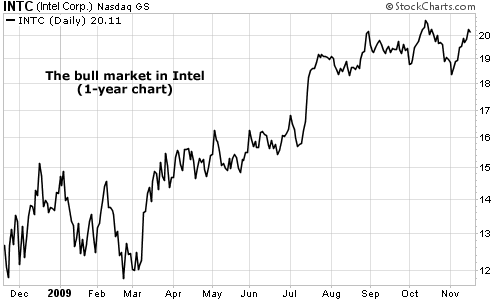| Home | About Us | Resources | Archive | Free Reports | Market Window |
Find America's Next Big Bankruptcy HereBy
Wednesday, November 18, 2009
Last week, I was in the mountains of Argentina for the inauguration of Doug Casey's real estate development, the Estancia de Cafayate. It was a week full of cocktail parties, golf tournaments... and unconventional ideas.
In between all the fun, I attended a small, private investment conference. The only speakers were Rick Rule, Doug Casey, Bill Bonner, and Porter Stansberry. Porter gave the best speech. He presented a compelling argument that one of the largest companies in America is bankrupt and its stock must go to zero by 2011. Before I present Porter's case, first consider Porter's track record for unearthing these bankruptcies. For three years, Porter told his readers over and over again that General Motors was bankrupt. He thumped the table a hundred times about it. Then he gave the same warnings about Fannie Mae, Freddie Mac, and the Wall Street banks months before they folded. No other analyst I know of has a better track record for predicting the major corporate collapses of the past two years. Porter says these major corporate bankruptcies are easy to find. Here's how he does it: First, he looks for companies that increase their short-term debts. This subtle act of desperation always indicates a company that's having trouble with its finances... Short-term debts are debts you have to pay back within one year. These debts have lower interest rates than long-term debts because they carry less uncertainty. The downside is, you have to pay them back sooner. Then Porter tries to imagine what would happen if creditors charged the company higher interest rates. Could the business handle it? GM was perfect example. Even when it carried an investment-grade credit, it still couldn't make enough money selling cars to cover their interest costs. When the ratings agencies downgraded GM's debt, the ship sank. Fannie Mae had the same problem. It financed mortgages with short-term debts. When interest rates rose, it blew up. Finally, Porter looks for a jettison of assets. Companies struggling with debts will sell their best assets to raise money. GM was forced to sell GMAC, Suzuki, Isuzu, and Hummer, for example. These asset sales always speed up the decline. The moment the market forces you to sell something, it loses half its value. But the debt secured against it keeps its value. You can figure out if a company is headed for bankruptcy just by looking at its annual report. First, search for the word "maturity." It'll bring up the company's debt-repayment schedule. Compare this result to prior years to see if short-term debt has increased. While you have the annual report open, look up interest expense in the income statement. Compare this to free cash flow in the cash flow statement. This tells you how comfortably a company can afford its debt. For asset sales, you could search the annual report for "divestitures," but the CEO will probably mention the big ones in his letter to shareholders at the beginning of the report. (He'll remind shareholders what a good decision it was to sell those assets.) In Cafayate, Porter told us which iconic American company goes bankrupt next... This company fell into the classic short-term borrowing trap. It has a $100-plus billion block of debt to repay over 2011 and 2012. This company is currently paying around $17 billion a year to service its $500 billion of debt. That's an interest rate of around 3.3%. But it only banked $12 billion in earnings after expenses last year. So there's a huge hole in the finances... even with its funding costs at 3.3%. When funding costs rise, the ship will fall apart. Finally, Management has been running a yard sale. In the past five years, this company has sold off its best businesses. "The common stock – every single share," concludes Porter, "is not worth one penny." Finding the next big bankruptcy is easy. Look for companies that pay more in interest than they receive in income from their businesses, shortening debt maturities, and corporate fire sales. Find these patterns, and you've got a looming bankruptcy... Good investing, Tom P.S. For the name of America's next big bankruptcy, you have to subscribe to Porter's newsletter, Porter Stansberry's Investment Advisory. I drop everything to read it the moment it lands in my inbox. And his latest issue is in the works. To learn more, click here.
Further Reading:
This Is Where I'll Go to Escape America Market NotesTHE MARKET ALWAYS LEADS THE NEWS – A CASE STUDY
Speaking of our favorite "real world" indicators: Our Intel idea is playing out as predicted...
Longtime readers know we see Intel as a high-tech version of Dr. Copper. Intel is the world's dominant producer of semiconductors, the little engines that power computers. In today's high-tech age, that's like saying Intel powers the world. Back in March – during the darkest days of the economy and stock market – we noted how Intel shares had formed a bottom and worked higher. Since the market always leads the news and never the other way around, we claimed if Intel shares broke $15, it would herald signs of economic life. Well, Intel broke $15 in the face of awful news, which we profiled here. Shares then climbed to $16 well before anyone thought things were getting better. Now, Intel's CFO claims computer sales could recover by next year. Shares are at $20. As long as they remain above their summer lows, we have to say the same thing about Intel as we do about the Baltic Dry Index, "If this guy is rising, things ain't so bad!" 
|
In The Daily Crux
Recent Articles
|

